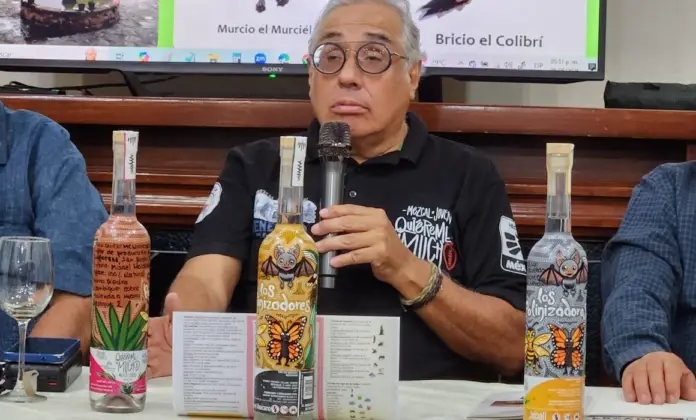With characters inspired by bees, bats, and hummingbirds, businessman Eduardo Muñozcano Skidmore and engineer Julio Palau Ranz presented the project Los Pollinizadores at the Hostería de Alcalá, a cultural and educational initiative that seeks to raise environmental awareness through the lens of mezcal.
The presentation was opened by host José Luis Varela, owner of the historic Hostería de Alcalá, who welcomed attendees and highlighted the value of the venue as a vibrant space for encounter, culture, and hospitality.
He spoke movingly about the history of the venue and its sense of community belonging in the heart of Oaxaca City.
Journalist and sociologist Juan Pérez Audelo reflected on Muñozcano’s career as a visionary businessman, his commitment to sustainability, and the originality of the project, which emerged during the pandemic.
He also recalled the promoter’s family origins, rooted in mezcal and the land of Taviche.
Muñozcano recounted how, after returning to the hacienda that belonged to his family, he decided to reclaim it not only as a productive space, but as a regenerative ecosystem, creating the mezcal Quiéreme Mucho, in memory of his mother and grandmother.
Furthermore, by promoting beekeeping, the recovery of gravity-fed water, the planting of native flora, and now, the Los Pollinizadores project, inspired by direct observation of the environment—bats, hummingbirds, butterflies—he developed, together with Julio Palau, a narrative with characters that represent the natural guardians of the agave.
Palau, with experience in technological innovation and the development of educational methodologies, explained the scope of the project, initially intended for his grandchildren: a children’s story available in four languages (Spanish, English, Zapotec, and Chinese), animated videos, musical pieces, printed and interactive materials, as well as a website hosting the story and educational activities of Murcio, Bricio, Bea, Agavina, Mayáhuel, and other characters who face the ecological damage caused by humans.
In addition, the creation of the Santuario de la Vida (Sanctuary of Life) was announced, an ecological space dedicated to pollinators in the Central Valleys region, with beehives, permanent flowering plants, and no electrical wiring, serving as a living reserve and a concrete proposal for sustainability.
The event concluded with a collective call to care for the environment based on the roots of our customs, with mezcal as a symbol of territory, tradition, and future.
Also with a tasting of mezcal that includes different magueys, tepestate, tobalá, and a variety that you can locate based on the brand, with bottles that are a work of art crafted by artisans from Tilcajete.

Source: oaxaca.quadratin




